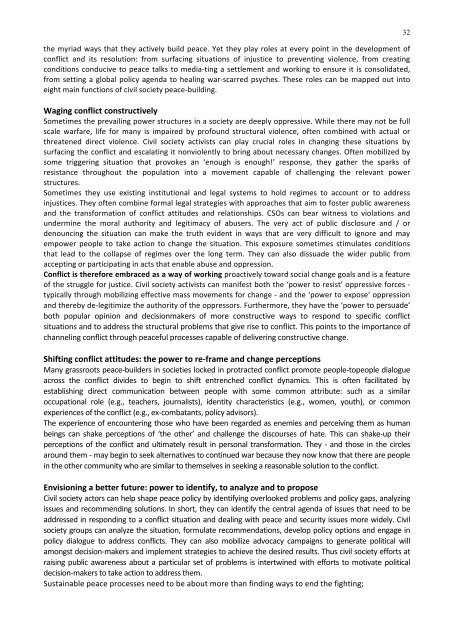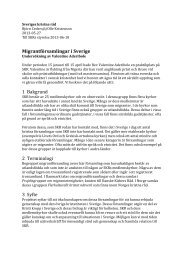Tyngdpunktsförskjutning rapport (PDF) - Sveriges kristna råd
Tyngdpunktsförskjutning rapport (PDF) - Sveriges kristna råd
Tyngdpunktsförskjutning rapport (PDF) - Sveriges kristna råd
You also want an ePaper? Increase the reach of your titles
YUMPU automatically turns print PDFs into web optimized ePapers that Google loves.
the myriad ways that they actively build peace. Yet they play roles at every point in the development of<br />
conflict and its resolution: from surfacing situations of injustice to preventing violence, from creating<br />
conditions conducive to peace talks to media-‐ting a settlement and working to ensure it is consolidated,<br />
from setting a global policy agenda to healing war-‐scarred psyches. These roles can be mapped out into<br />
eight main functions of civil society peace-‐building.<br />
Waging conflict constructively<br />
Sometimes the prevailing power structures in a society are deeply oppressive. While there may not be full<br />
scale warfare, life for many is impaired by profound structural violence, often combined with actual or<br />
threatened direct violence. Civil society activists can play crucial roles in changing these situations by<br />
surfacing the conflict and escalating it nonviolently to bring about necessary changes. Often mobilized by<br />
some triggering situation that provokes an ‘enough is enough!’ response, they gather the sparks of<br />
resistance throughout the population into a movement capable of challenging the relevant power<br />
structures.<br />
Sometimes they use existing institutional and legal systems to hold regimes to account or to address<br />
injustices. They often combine formal legal strategies with approaches that aim to foster public awareness<br />
and the transformation of conflict attitudes and relationships. CSOs can bear witness to violations and<br />
undermine the moral authority and legitimacy of abusers. The very act of public disclosure and / or<br />
denouncing the situation can make the truth evident in ways that are very difficult to ignore and may<br />
empower people to take action to change the situation. This exposure sometimes stimulates conditions<br />
that lead to the collapse of regimes over the long term. They can also dissuade the wider public from<br />
accepting or participating in acts that enable abuse and oppression.<br />
Conflict is therefore embraced as a way of working proactively toward social change goals and is a feature<br />
of the struggle for justice. Civil society activists can manifest both the ‘power to resist’ oppressive forces -‐<br />
typically through mobilizing effective mass movements for change -‐ and the ‘power to expose’ oppression<br />
and thereby de-‐legitimize the authority of the oppressors. Furthermore, they have the ‘power to persuade’<br />
both popular opinion and decisionmakers of more constructive ways to respond to specific conflict<br />
situations and to address the structural problems that give rise to conflict. This points to the importance of<br />
channeling conflict through peaceful processes capable of delivering constructive change.<br />
Shifting conflict attitudes: the power to re-‐frame and change perceptions<br />
Many grassroots peace-‐builders in societies locked in protracted conflict promote people-‐topeople dialogue<br />
across the conflict divides to begin to shift entrenched conflict dynamics. This is often facilitated by<br />
establishing direct communication between people with some common attribute: such as a similar<br />
occupational role (e.g., teachers, journalists), identity characteristics (e.g., women, youth), or common<br />
experiences of the conflict (e.g., ex-‐combatants, policy advisors).<br />
The experience of encountering those who have been regarded as enemies and perceiving them as human<br />
beings can shake perceptions of ‘the other’ and challenge the discourses of hate. This can shake-‐up their<br />
perceptions of the conflict and ultimately result in personal transformation. They -‐ and those in the circles<br />
around them -‐ may begin to seek alternatives to continued war because they now know that there are people<br />
in the other community who are similar to themselves in seeking a reasonable solution to the conflict.<br />
Envisioning a better future: power to identify, to analyze and to propose<br />
Civil society actors can help shape peace policy by identifying overlooked problems and policy gaps, analyzing<br />
issues and recommending solutions. In short, they can identify the central agenda of issues that need to be<br />
addressed in responding to a conflict situation and dealing with peace and security issues more widely. Civil<br />
society groups can analyze the situation, formulate recommendations, develop policy options and engage in<br />
policy dialogue to address conflicts. They can also mobilize advocacy campaigns to generate political will<br />
amongst decision-‐makers and implement strategies to achieve the desired results. Thus civil society efforts at<br />
raising public awareness about a particular set of problems is intertwined with efforts to motivate political<br />
decision-‐makers to take action to address them.<br />
Sustainable peace processes need to be about more than finding ways to end the fighting;<br />
32









